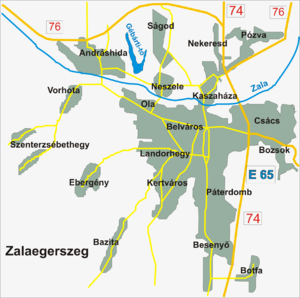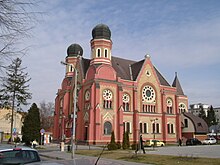Zalaegerszeg
| Zalaegerszeg | ||||
|
||||
| Basic data | ||||
|---|---|---|---|---|
| State : | Hungary | |||
| Region : | Western Transdanubia | |||
| County : | Zala | |||
| Small area until December 31, 2012 : | Zalaegerszeg | |||
| Coordinates : | 46 ° 50 ' N , 16 ° 51' E | |||
| Area : | 99.98 km² | |||
| Residents : | 61,970 (Jan. 1, 2011) | |||
| Population density : | 620 inhabitants per km² | |||
| Telephone code : | (+36) 92 | |||
| Postal code : | 8900 | |||
| KSH kódja: | 32054 | |||
| Structure and administration (status: 2014) | ||||
| Community type : | city | |||
| Mayor : | Zoltán Balaicz (Fidesz-KDNP) | |||
| Postal address : | Kossuth Lajos u. 17–19 8901 Zalaegerszeg |
|||
| Website : | ||||
| (Source: A Magyar Köztársaság helységnévkönyve 2011. január 1st at Központi statisztikai hivatal ) | ||||
Zalaegerszeg [ ˈzɒlɒɛɡɛrsɛɡ ] ( German Egersee ) is a town with county law in Hungary and at the same time the administrative seat of Zala county . In 2011 it had 61,970 inhabitants and is located on the Zala River . The city is about 210 km from Budapest .
history
Based on archaeological finds (the oldest in Zala county) it can be assumed that the area was already settled in the late Paleolithic . Celts later settled in the area.
The city itself was first mentioned in 1247 as Egerscug. In 1293 the name had already changed to Egerszeg.
The town became church property when King Béla IV donated the town to the diocese of Veszprém in 1266. However, since the distance to Veszprém was very long for the time, taxes rarely arrived in Veszprém, but often ended up in the coffers of local princes such as the Kőszegi family .
In the 14th century the city was already the largest in the area. Between 1368 and 1389 ownership changed for a short time and it came under royal administration. King Sigismund then gave the city to the Kanizsai family , who later exchanged it for another to the bishop of Veszprém. There it remained in church ownership until 1848. The first stone church was built in the city in 1381. In 1421 the city got market rights, which also meant that the residents only had to pay taxes once a year and were allowed to elect their own judges. The city grew steadily and in the 16th century it was the real center of Zala County.
This development came to a standstill, however, that due to royal weakness the individual noble houses gained more and more power and tried to take possession of the city through raids. In addition, the Turks began to occupy Hungary in 1526 after the Battle of Mohács . From 1568 the city was fortified and a castle was built. The first unsuccessful attack by the Turks on the city took place in the 1570s. After the Turks had conquered the neighboring city of Kanizsa , the strategic importance of the city grew more and more. In 1616 the castle was badly damaged in an attack by the Turks and in 1664 they even captured the castle for a short time. During this time, the population suffered not only from the war, but also from epidemics and high taxes.
Although Egerszeg was only a border town of the county , it was made the capital in the 18th century. The county assemblies were held in the city anyway, because the city was considered so important and it was not subject to any prince like the other cities in the county.
The assembly hall was built in the years 1730–1732 in the Baroque style and for a long time was the only representative building in the city. A large church and barracks were added in the 1760s. Since the city itself largely consisted of wooden houses, devastating fires repeatedly broke out and destroyed the city. This only ended when the town was rebuilt with stone houses in 1826.
Until the early 19th century there were hardly any artisans and merchants in the city because they would have had to pay taxes to the bishop. In the 1830s there were 10% Jews among the population while the predominant belief was Catholic. But the mainly commercial Jews did not give the city's economy any boost either. Despite its administrative position in the country, the city played no role economically or culturally. This is also reflected in the fact that, despite a population of 3500, there were only two primary schools. The cultural centers of the area were Kanizsa and Keszthely .
In the freedom struggle of 1848/1849, the city only played a subordinate role. In 1870 it even lost its town status and became a village again. However, it regained city status in 1885 and in 1887 the village of Ola was incorporated.
In 1890 Zalaegerszeg was connected to the railway line from Ukk to Csáktornya . In the following years, a large number of public buildings were built, such as a town hall, a hotel, a kindergarten and a brick factory, but this emptied the city coffers so much that the then mayor Károly Kovács had to resign. His successor Lajos Botfy was able to reduce the debt burden and promote urban development.
The economic boom actually only began in the 1920s, when the new post office, train station, fire station, police headquarters and Notre Dame monastery were built. The synagogue was built in 1904.
The deportation of 1,221 Jews to Auschwitz during the Second World War was a dark chapter in the city's history . On March 28, 1945, the city was liberated from the Nazis by the Red Army . In the first election in 1949, the communists only got 10% of the vote, but still ruled the city.
In the 1950s the city became more and more industrial. A textile factory was established and in 1952 oil was discovered. As more and more commuters from the surrounding villages had to drive to work in the city, the railway line was expanded. As there was a shortage of housing in the city, opponents of the system were forced by the government to leave the city and move to another location.
On October 26, 1956, the residents of Zalaegerszeg also took part in the revolution . The communist city tour fled to Körmend and a revolutionary committee ruled until the arrival of the Soviet army (on November 4th).
In the 1960s and 1970s, there was an enormous population increase due to heavy housing construction. The city limits were expanded and the villages of Csácsbozsok, Botfa, Zalabesenyő, Bazita, Andráshida and Pózva were incorporated. After the end of socialist rule, Zalaegerszeg was not hit by the economic recession like other cities, but continued to develop in the 1990s.
In 2001 the city hosted the Central European Olympiad in Informatics (CEOI).
Attractions
- Bazita TV tower
- Open-air museum: the first ethnographic museum in Hungary, with a Finnish-Ugric collection
- Museum of the Oil Industry
- Göcsejer Museum (Hungarian Göcseji Múzeum )
- Aquacity - water park in the Ságod district
- Deák Square with the former county house
- Gébárter Craftsman's House (Hungarian: Gébárti Kézmüvesekháza )
- Franciscan Church
- Castle Hűvös-Erdődy family Erdődy
Twin cities
|
sons and daughters of the town
- Ferenc Deák (1803–1876), representative in Parliament, Minister of Justice
- József Mindszenty (original name: József Pehm, 1892–1975), primate of Hungary
- David Schwarz , inventor of the rigid airships
- Annamária Szalai (1961–2013), politician and journalist
- Lajos Portisch (* 1937), chess grandmaster
- László Andor (* 1966), economist and EU commissioner
- Katalin Vidor (1903–1976), concentration camp survivor, author
Web links
- City website ( Hungarian , German , English )
- Zala-Egerszeg in A Pallas nagy lexikona (Hungarian)
- Aerial photos over Zalaegerszeg








